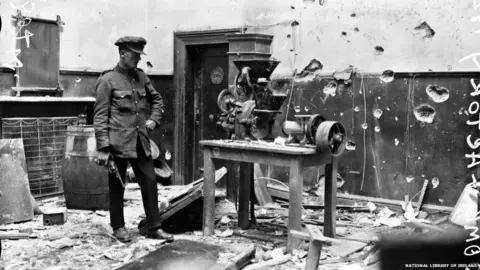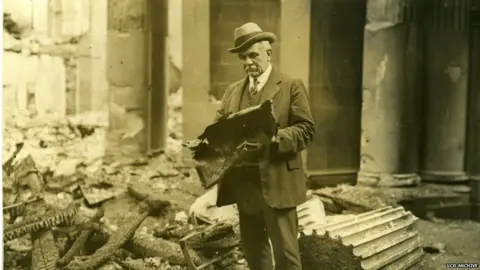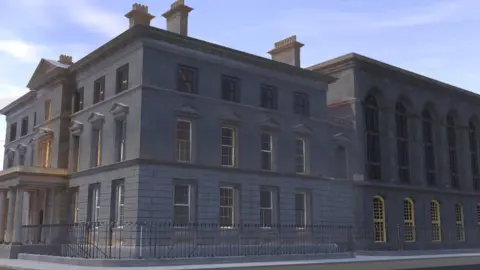Out of the ashes - Ireland's archives reborn
 National Library of Ireland
National Library of IrelandOne hundred years ago this week, Ireland was plunged into civil war and much of its history seemed to go up in smoke.
An attack on the Four Courts in Dublin marked the beginning of a bitter civil war between those who supported the Anglo-Irish Treaty and those opposed to it.
Ireland's Public Record Office - a precious history - was destroyed.
On 30 June, as the building burned, the official documents charting a country through the centuries burned with it.
When the deputy keeper of the Public Record Office, Herbert Wood, saw the damage, he said that "at one blow, the records of centuries have passed into oblivion".
 UCD Archive
UCD ArchiveThree years earlier, he had written a book - A Guide to the Records Deposited in the Public Record Office of Ireland.
It would later become known as "the most depressing book in Irish history", as it catalogued hundreds of thousands of documents which had been destroyed and were considered lost forever.
But a century later, it is clear that all was not lost.
A ground-breaking project, The Virtual Record Treasury of Ireland - the Beyond 2022 project, has uncovered a treasure trove.
Archives from around the world joined forces to share their documents and bring the destroyed records back to life.
It spans an arc of Irish history from 1174 right up to 1922.
 Irish Architectural Archive
Irish Architectural ArchiveVisitors will be able to "step back in time" to explore a virtual recreation of the Public Record Office of Ireland and its collections, as they were on the eve of their destruction at Dublin's Four Courts at the outset of the civil war.
About 150,000 records, ranging from single sheets to entire series of bound volumes, and more than 6,000 maps are online.
This is a vast treasury of replacement documents discovered in partner archives around the world.
They chart seven centuries of Irish history and are free to everyone with an interest in Ireland's past.
The treasury is the outcome of a five-year state-funded programme of research led by Trinity College, Dublin, called Beyond 2022.
It combines historical investigation, archival conservation and technical innovation to re-imagine and recreate, through digital technologies, the archive that was lost on 3 June 1922.
The Taoiseach (Irish PM) Micheál Martin called it an "enduring and meaningful legacy".
"It belongs to the people of Ireland, democratising access to our rich archival heritage and making our shared history accessible for everyone," he said.
"It is an invaluable historical resource for people of all traditions across the island and for everyone of Irish heritage around the world."
 Beyond 2022/Fennell Photography
Beyond 2022/Fennell PhotographyHistorians from TCD worked alongside computer scientists in the to create the archive made in partnership with the National Archives of Ireland; National Archives (UK); the Public Record Office of Northern Ireland; the Irish Manuscripts Commission and the Library of Trinity College Dublin.
People will be able to:
- 'Step inside' the six-storey Victorian Public Record Office, as it was on the eve of its destruction in 1922, via an immersive 3D experience
- Search the Treasury's collection of 50 million words of text, 150,000 records and more than 6,000 maps spanning an arc of Irish history from 1174 right up to 1922
- Find out about Ireland's first census which took place in 1766, discover how the country was intensely mapped during the Cromwellian era or how Ireland was governed by the English crown in the Middle Ages
- Discover the Three Gold Seam collections, where up to 80% of the lost material has been retrieved
- Dive into Ireland's past with the Knowledge Graph for Irish History - a research tool which allows for the discovery of new connections between people and places with 2.7 million linked data entities available to search
You can find out much more about the partition of the island of Ireland in 1921 by listening back to the BBC podcast series, Year '21, on BBC Sounds.
